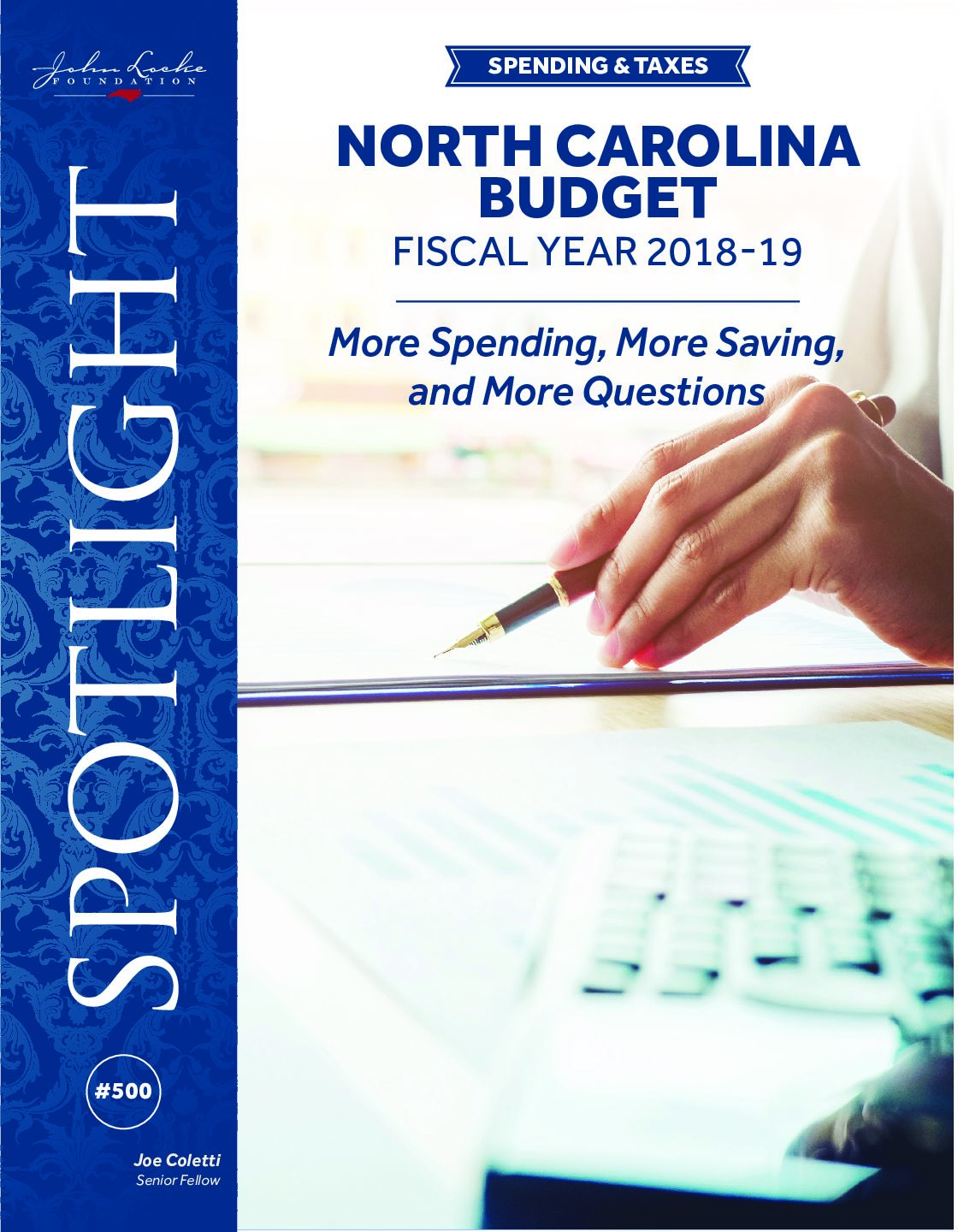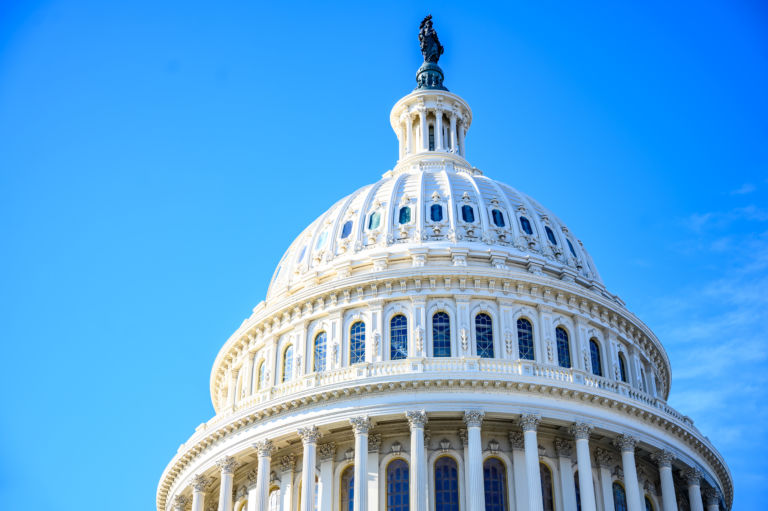Overview
For a second straight year, state legislators overrode Gov. Roy Cooper’s veto to enact a state budget. The $23.9 billion General Fund budget for Fiscal Year 2018-19 is 3.85 percent larger than the prior year. It includes higher salaries for nearly every state employee, sets aside $221 million for rainy day savings, and keeps tax changes enacted in 2017 that will save taxpayers $1 billion per year starting Jan. 1, 2019.
After restoring the state’s finances with strict fiscal discipline of 2.7 percent annual spending growth since 2011, the legislature relaxed their parameters with growth of 3.85 percent in this budget. Nonprofits and local governments will receive $60 million in direct appropriations, the film industry will receive $31 million in grants, and Apple or Amazon could qualify for new tax incentives targeted to information technology. Outside of the budget, the governor signed a bill to permit $3 billion in new transportation-funded debt that will not need voters’ approval to build local roads. The budget directed more lottery money for school construction to postpone a potential $1.9 billion bond for school construction.
The spending increase passed by the legislature pales in comparison to the reckless and incomplete budget proposed by Gov. Cooper. His proposal was not sent as an actual bill to the legislature, where it would have been ignored. This is the first time in more than a generation that a governor did not submit a budget bill for consideration. For their part, legislators passed their budget using a process that precluded amendment or committee deliberations.
Gov. Cooper and the North Carolina General Assembly will need to return to the path of fiscal discipline in future budgets. Gov. Cooper’s proposed budget would have raised taxes and spent every dollar, creating a need for still higher taxes or lower spending in the next fiscal year. The General Assembly passed a budget that could delay that fiscal reckoning for a year.
Spending
Just about every state employee gets a raise in the budget. For most state employees, the pay increase will be 2 percent. The lowest-paid employees will get a boost to make their annual pay $31,200. Corrections officers and other prison employees will receive an average 4 percent increase, and state troopers will see their pay climb 8 percent on average with differences based on longevity. Teacher pay increases will also vary based on years of service, but the average increase will be 6.5 percent. School principals will see an average increase of 6.9 percent. All of the pay increases combined add $449 million in General Fund appropriations. Retirees receive a one-time 1 percent increase in their pension payments. Pension and health benefits for employees and retirees climb $255 million.
General Fund appropriations climb $900 million to $23.9 billion. That 3.85 percent increase is similar to the standard of inflation and population growth. With different definitions, however, the inflation-adjusted cost of government per person could be climbing. Other measures of inflation are lower than the forecast consumer price index commonly used, the CPI-U, which projects a 2.9 percent increase. Actual inflation in recent years has been slower than forecasts. This has not been a concern in past budgets, because spending grew by an average of 2.7 percent per year between 2011 and 2017, as compared to the 3.85 percent increase this year. Consistent treatment of spending on capital improvements would lead to spending growth of between 4.07 percent (operations only) and 4.52 percent (operations and capital improvements). Budget writers should have made clear the impact of reclassifying capital as a reduction in revenue instead of an increase in spending.
Education spending will increase $700 million (5.3 percent) to $13.8 billion, which consists of $9.5 billion for K-12 schools, $3 billion for the university system, and $1.2 billion for community colleges. Medicaid will receive $110 million more (3 percent) to reach $3.8 billion, plus $10.8 billion in receipts from the federal government, hospital assessments, and pharmaceutical rebates. Spending on other health and human service programs will decrease $12 million (-0.8 percent) to $1.5 billion, with $4.3 billion in receipts. This is the area with the greatest concentration of budgeted federal funds.
Public safety, including the courts and corrections systems, will increase $92 million (3.4 percent) to $2.8 billion. Debt service is down $11 million (1.5 percent) to $718 million; appropriations for general government, agriculture, environment, and the rest of state government will be up $8.5 million (0.7 percent) to $1.3 billion.
Savings
The Savings Reserve (rain day fund) reaches its highest level ever in dollars and as a share of General Fund appropriations. With $221 million added in this budget, the Savings reserve exceeds $2 billion, or 9.6 percent of appropriations. Its target level to meet projected fiscal needs in nine of 10 recessions is 11.3 percent of appropriations.
Lawmakers importantly leave an unspent balance of $561 million. With only minimal changes in the budget for Fiscal Year 2019-20, Fiscal Research expects a $79 million surplus after drawing down the unspent balance. In contrast, Gov. Cooper would have spent every dollar in Fiscal Year 2018-19, even after raising taxes, and would leave a $469 million hole in the budget for Fiscal Year 2019-20.
Taxes
The legislature’s budget keeps the tax cuts passed last year, reducing the corporate income tax rate to 2.5 percent on Jan. 1, 2019, from 3 percent in 2018, and the personal income tax rate to 5.25 percent from 5.499 percent. The standard deduction climbs to $10,000 from $8,750 for an individual and $20,000 from $17,500 for married taxpayers filing jointly. The larger standard deduction means more people will have no tax burden. It also means people with higher income pay a larger percentage of their income in taxes than those with lower income, even if each dollar is taxed the same amount. For example, a single taxpayer earning $20,000 would pay tax on just half of his income for an effective tax rate of 2.625 percent, but another taxpayer earning $100,000 would pay tax on 90 percent of her income for an effective tax rate of 4.725 percent.
Gov. Cooper’s budget would have created a two-tier tax code, raising taxes $110 million by rolling back scheduled tax cuts for corporations and individuals who earn $100,000 or more. In Fiscal Year 2019-20, revenue from Cooper’s tax hikes would have climbed to $282 million.
Federal tax reforms carried into the budget will add $59 million in revenue and give parents an opportunity to use their 529 savings plans for K-12 schooling. The budget also includes potential tax incentives aimed at Apple and Amazon as they consider whether to create a large campus in the Research Triangle region.
Government Efficiency and Reform
A little-noticed but important provision spends $37 million for an Enterprise Resource Planning system. This software is critical to better management and understanding of state government operations. Currently, legislators and government managers do not know the full portfolio of state facilities, number of state-owned vehicles, or inventory of other capital goods and assets. Agency directors do not have a central resource to compare actual spending and budget in a comprehensive way, which makes planning and implementation a challenge. A pilot budget reform in the Department of Public Safety would attempt to align the next proposed budget with actual spending patterns and remove the agency’s ability to eliminate positions without “express authorization” of the General Assembly.
Earmarks
The John Locke Foundation identified 206 line-items in the Fiscal Year 2018-19 budget that appropriate funds to specific local governments and nonprofit organizations, up from 100 in the Fiscal Year 2017-18 budget. Some of these grants will go to multiple organizations, so the number of governments and nonprofits receiving earmarked funds in each year is greater still. Overall, the budget directs $60 million in this way, more than double the $28 million in earmarks for Fiscal Year 2017-18. Of these earmarked funds, $49 million will go to nonprofits and $11 million will be distributed to local governments.
Some of the programs, such as StepUp Wilmington, which provides job and life skills training, and TROSA, a residential substance abuse treatment center that earns money through a number of businesses that employ its residents, are extremely worthwhile with proven records of success. However worthy the organization or expense, though, many of the grants simply appropriate money without a stated reason or goal for the funds. Earmarking like this is the wrong approach to state government budgeting. For government, grants should be competitive. For nonprofits, government funding is an unpredictable source of revenue compared to the private funds it potentially supplants.
Capital, Infrastructure, Repairs, and Renovations
In the Fiscal Year 2018-19 budget, lawmakers reclassifying capital projects totaling over $155 million as a reduction in revenue instead of an appropriation, is a change from past practice. Adjusted for this change, the increase in spending is between 4 percent (operations only) and 4.5 percent (operations and capital combined). Beginning in Fiscal Year 2019-20, capital projects will be funded through the Capital and Infrastructure Pay-As-You-Go Fund. One-fourth of the previous year’s unreserved balance will go to this fund, which will continue to count as a reduction in revenue, not an increase in spending.
Now that the funding structure is set, lawmakers should stick with it. Funding capital projects outside of the traditional appropriation process can create temptations to define more spending as capital. Recognizing this temptation, the budget has a provision to define anything less than $100,000 as an operating expense. Budget writers and observers will need to be diligent in watching how money flows through this fund. States use five-year averages on their pension assets to smooth annual swings in market returns, and thereby the annual required contribution. A similar five-year moving average of capital expenditures could mitigate year-to-year capital spending volatility.
Conclusion
The General Assembly had established a solid record of good fiscal management in previous budgets. What became law is far better than Gov. Cooper’s spendthrift approach to raising taxes, but the General Assembly used a bad process and some subtle accounting maneuvers to keep spending per person constant after adjusting for inflation. We hope for a more complete and realistic proposal from Gov. Cooper in 2019 and expect a return to more fiscal restraint from the legislature.



